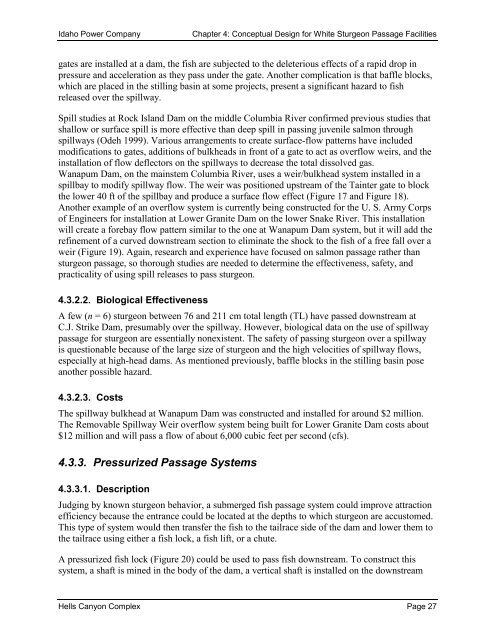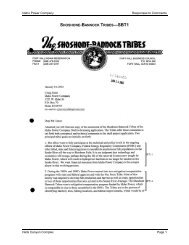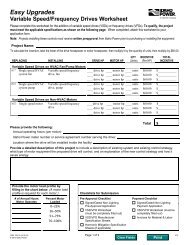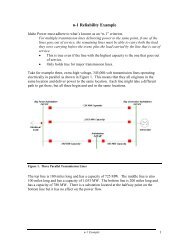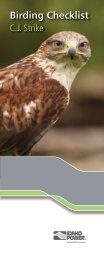Snake River White Sturgeon Conservation Plan ... - Idaho Power
Snake River White Sturgeon Conservation Plan ... - Idaho Power
Snake River White Sturgeon Conservation Plan ... - Idaho Power
Create successful ePaper yourself
Turn your PDF publications into a flip-book with our unique Google optimized e-Paper software.
<strong>Idaho</strong> <strong>Power</strong> CompanyChapter 4: Conceptual Design for <strong>White</strong> <strong>Sturgeon</strong> Passage Facilitiesgates are installed at a dam, the fish are subjected to the deleterious effects of a rapid drop inpressure and acceleration as they pass under the gate. Another complication is that baffle blocks,which are placed in the stilling basin at some projects, present a significant hazard to fishreleased over the spillway.Spill studies at Rock Island Dam on the middle Columbia <strong>River</strong> confirmed previous studies thatshallow or surface spill is more effective than deep spill in passing juvenile salmon throughspillways (Odeh 1999). Various arrangements to create surface-flow patterns have includedmodifications to gates, additions of bulkheads in front of a gate to act as overflow weirs, and theinstallation of flow deflectors on the spillways to decrease the total dissolved gas.Wanapum Dam, on the mainstem Columbia <strong>River</strong>, uses a weir/bulkhead system installed in aspillbay to modify spillway flow. The weir was positioned upstream of the Tainter gate to blockthe lower 40 ft of the spillbay and produce a surface flow effect (Figure 17 and Figure 18).Another example of an overflow system is currently being constructed for the U. S. Army Corpsof Engineers for installation at Lower Granite Dam on the lower <strong>Snake</strong> <strong>River</strong>. This installationwill create a forebay flow pattern similar to the one at Wanapum Dam system, but it will add therefinement of a curved downstream section to eliminate the shock to the fish of a free fall over aweir (Figure 19). Again, research and experience have focused on salmon passage rather thansturgeon passage, so thorough studies are needed to determine the effectiveness, safety, andpracticality of using spill releases to pass sturgeon.4.3.2.2. Biological EffectivenessA few (n = 6) sturgeon between 76 and 211 cm total length (TL) have passed downstream atC.J. Strike Dam, presumably over the spillway. However, biological data on the use of spillwaypassage for sturgeon are essentially nonexistent. The safety of passing sturgeon over a spillwayis questionable because of the large size of sturgeon and the high velocities of spillway flows,especially at high-head dams. As mentioned previously, baffle blocks in the stilling basin poseanother possible hazard.4.3.2.3. CostsThe spillway bulkhead at Wanapum Dam was constructed and installed for around $2 million.The Removable Spillway Weir overflow system being built for Lower Granite Dam costs about$12 million and will pass a flow of about 6,000 cubic feet per second (cfs).4.3.3. Pressurized Passage Systems4.3.3.1. DescriptionJudging by known sturgeon behavior, a submerged fish passage system could improve attractionefficiency because the entrance could be located at the depths to which sturgeon are accustomed.This type of system would then transfer the fish to the tailrace side of the dam and lower them tothe tailrace using either a fish lock, a fish lift, or a chute.A pressurized fish lock (Figure 20) could be used to pass fish downstream. To construct thissystem, a shaft is mined in the body of the dam, a vertical shaft is installed on the downstreamHells Canyon Complex Page 27


